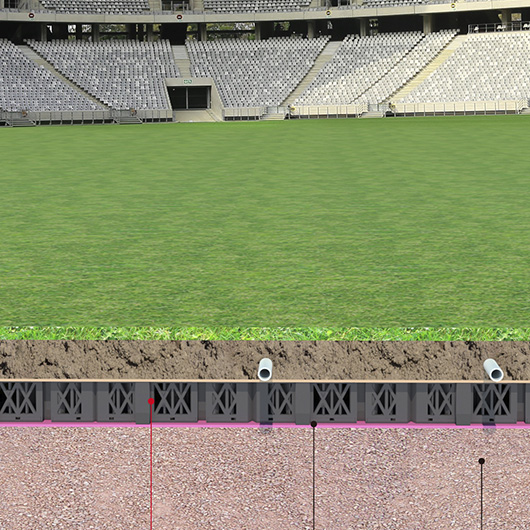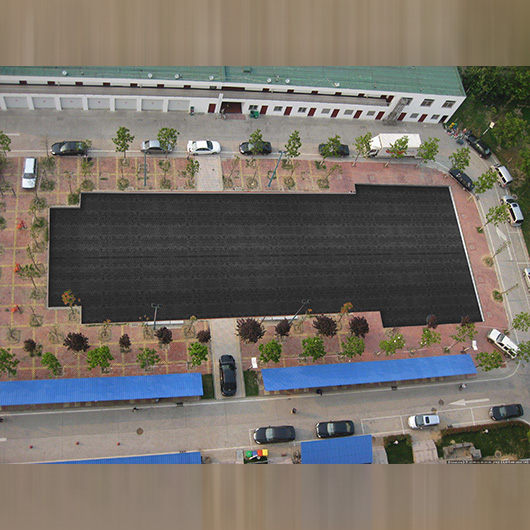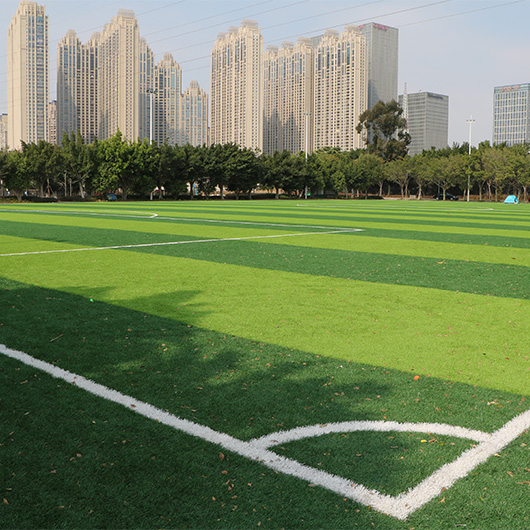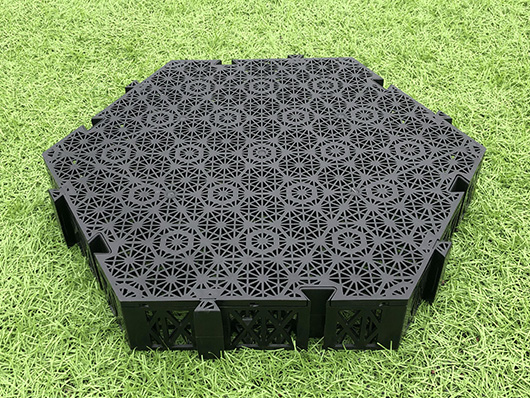Athletic Fields Application
Athletic Fields Drainage System and Ideal Geocellular Soakaway
Better effect on infiltration, elimination of settlement
Features of Athletic Fields Drainage System Yard Drainage System provided by HOENSOEY geocellular soakaway:
- Maximally improve water infiltration and storage, and protect costly artificial turf;
- Eliminating the need to dig roads to install water collection pipes, conserving materials, and improving stormwater source control;
- The use of high-intensity interconnecting devices enables even load distribution and eliminates the problem of pavement settling;
- Ideal graded athletic fields for all levels of competition;


Stormwater reuse
- Athletic Fields Drainage System and Yard Drainage System perform well in rainwater treatment. The cost of excavation is minimized, and the rainwater can quickly infiltrate underground to reduce surface runoff, which meets the goals of the Best Management Practice (BMP) evaluation system for rainwater;
- Multiple drainage functions are together to offset the cost;
- Design rainwater retention areas to easily and naturally re-use rainwater on site.
Saving time, saving effort, saving materials
HOENSOEY geocellular soakaway provide ideal landscape drainage solutions that save time, effort and materials. It is the best choice for Synthetic Turf Football Field Drainage and Yard Drainage. There are some advantages for Athletic Fields Drainage System and the Yard Drainage System:
1. Reduce construction time and cost. The HOENSOEY geocellular soakaway interconnects the entire system to simplify the solution to stormwater retention problems.
2. Avoid roadbed problems. There is no need to lay down bedrock or dig deep pits to bury the pipeline facilities, thus avoiding roadbed contamination and high groundwater levels.
3. No laborious hauling of large quantities of material, and less damage to the surface of the road.

HOENSOEY Cell
HOENSOEY Cell(Geocellular Soakaway) is a new type of rainwater storage honeycomb units with ultra-high compression strength and unique buckles. They are a core component in shallow surface water treatment systems.
Drainage of lawns for sports fields
The athletic field lawn is large and flat. Drainage of playing fields is important to meet the needs of long-term competition. So, how did the construction of the artificial turf at the sports stadium work out? This article will present the construction method of artificial turf for the drainage of sports fields.
There are general three ways of athletic field drainage, for scenarios like: synthetic turf football field drainage and yard drainage.
Methods of surface drainage.
This is a common approach for many scenarios, including rain gardens, sports fields, etc. Rainwater flows from the field through the sports field's longitudinal and transverse slopes. About 80 percent of the rainwater in the field area can be removed. The design of the slope values and the construction requirements are very rigorous and precise.
The artificial turf of the sports fields is not a pure flat surface, but a tortoise-like shape. That is, it is high in the middle and low on all four sides, making it convenient for storm drainage. It was only because the court area was so large, and there were lawns on it, that we generally could not see it.
Base infiltration method
There are two types of drainage for the base infiltration method. First, residual water passes through the loose soil and seeps into the ground. After that, it is drained through the base blind ditch to the off-site ditch. On the other hand, groundwater can also be isolated to maintain natural surface water content, which is important for natural turf sports fields.
The base-level percolation and drainage are excellent. However, the specifications of the engineering materials are very strict, and the technical requirements for construction operations are very high. If it does not meet the requirements, it will not have the function of percolation and drainage, and may even become a stagnant layer.
Drainage of artificial turf for sports grounds is generally done by percolation. The underground seepage system is closely with the structure of the site, mostly in the form of blind ditch (underground drainage channel). The drainage slope of the outdoor artificial turf of sports field is controlled within 0.3%-0.8%, the slope of the artificial turf field of the sports field which is without water seepage is less than 0.8%, and the slope of the artificial turf field with water seepage function is 0.3%, which is less than 400mm.
Forced drainage method
The forced drainage method is to set a certain amount of water filter pipes at the base level. It forms a powerful drainage system. Water at the base level flows into a filter tube and discharged to the outside of the field via a vacuum pump. Thus, forced drainage is necessary.
If water accumulates on the artificial turf at a sports field, it can affect the outcome of a game at the sports field, as well as the life of the turf. It is therefore important to design drainage systems for artificial turf in sports fields.
Combined with the above mentioned drainage methods, HOENSOEY geocellular soakaway can greatly improve drainage efficiency in a rain garden or sports fields, such as synthetic turf football field, especially for base infiltration and drainage methods.
Last but not least, the purpose of use of HOENSOEY geocellular soakaway is to realize easy and fast athletic fields drainage. The entire process of irrigation does not need power, which saves a great deal of equipment cost as well as labor in watering.

